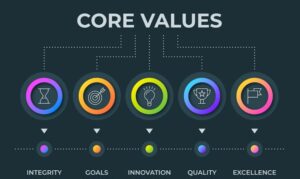Meeting the Challenge of Disruptive Change: It’s no wonder that innovation is so difficult for established firms. They employ highly capable people—and then set them to work within processes and business models that doom them to failure. But there are ways out of this dilemma. By Clayton M. Christensen and Michael Overdorf
These are scary times for managers in big companies. Even before the Internet and globalization, their track record for dealing with major, disruptive change was not good. Out of hundreds of department stores, for example, only one—Dayton Hudson—became a leader in discount retailing. Not one of the minicomputer companies succeeded in the personal computer business. Medical and business schools are struggling—and failing—to change their curricula fast enough to train the types of doctors and managers their markets need. The list could go on.
It’s not that managers in big companies can’t see disruptive changes coming. Usually they can. Nor do they lack resources to confront them. Most big companies have talented managers and specialists, strong product portfolios, first-rate technological know-how, and deep pockets. What managers lack is a habit of thinking about their organization’s capabilities as carefully as they think about individual people’s capabilities.
One of the hallmarks of a great manager is the ability to identify the right person for the right job and to train employees to succeed at the jobs they’re given. But unfortunately, most managers assume that if each person working on a project is well matched to the job, then the organization in which they work will be, too. Often that is not the case. One could put two sets of identically capable people to work in different organizations, and what they accomplished would be significantly different. That’s because organizations themselves—independent of the people and other resources in them—have capabilities. To succeed consistently, good managers need to be skilled not just in assessing people but also in assessing the abilities and disabilities of their organization as a whole.
This article offers managers a framework to help them understand what their organizations are capable of accomplishing. It will show them how their company’s disabilities become more sharply defined even as its core capabilities grow. It will give them a way to recognize different kinds of change and make appropriate organizational responses to the opportunities that arise from each. And it will offer some bottom-line advice that runs counter to much that’s assumed in our can-do business culture: if an organization faces major change—a disruptive innovation, perhaps—the worst possible approach may be to make drastic adjustments to the existing organization. In trying to transform an enterprise, managers can destroy the very capabilities that sustain it.
Before rushing into the breach, managers must understand precisely what types of change the existing organization is capable and incapable of handling. To help them do that, we’ll first take a systematic look at how to recognize a company’s core capabilities on an organizational level and then examine how those capabilities migrate as companies grow and mature.
Where Capabilities Reside In Meeting the Challenge of Disruptive Change
Our research suggests that three factors affect what an organization can and cannot do: its resources, its processes, and its values. When thinking about what sorts of innovations their organization will be able to embrace, managers need to assess how each of these factors might affect their organization’s capacity to change.
Resources.

When they ask the question, “What can this company do?” the place most managers look for the answer is in its resources—both the tangible ones like people, equipment, technologies, and cash, and the less tangible ones like product designs, information, brands, and relationships with suppliers, distributors, and customers. Without doubt, access to abundant, high-quality resources increases an organization’s chances of coping with change. But resource analysis doesn’t come close to telling the whole story.
Processes.
The second factor that affects what a company can and cannot do is its processes. By processes, we mean the patterns of interaction, coordination, communication, and decision making employees use to transform resources into products and services of greater worth. Such examples as the processes that govern product development, manufacturing, and budgeting come immediately to mind. Some processes are formal, in the sense that they are explicitly defined and documented. Others are informal: they are routines or ways of working that evolve over time. The former tend to be more visible, the latter less visible.
One of the dilemmas of management is that processes, by their very nature, are set up so that employees perform tasks in a consistent way, time after time. They are meant not to change or, if they must change, to change through tightly controlled procedures. When people use a process to do the task it was designed for, it is likely to perform efficiently. But when the same process is used to tackle a very different task, it is likely to perform sluggishly. Companies focused on developing and winning FDA approval for new drug compounds, for example, often prove inept at developing and winning approval for medical devices because the second task entails very different ways of working. In fact, a process that creates the capability to execute one task concurrently defines disabilities in executing other tasks.1
The most important capabilities and concurrent disabilities aren’t necessarily embodied in the most visible processes, like logistics, development, manufacturing, or customer service. In fact, they are more likely to be in the less visible, background processes that support decisions about where to invest resources—those that define how market research is habitually done, how such analysis is translated into financial projections, how plans and budgets are negotiated internally, and so on. It is in those processes that many organizations’ most serious disabilities in coping with change reside.
Values.

The third factor that affects what an organization can and cannot do is its values. Sometimes the phrase “corporate values” carries an ethical connotation: one thinks of the principles that ensure patient well-being for Johnson & Johnson or that guide decisions about employee safety at Alcoa. But within our framework, “values” has a broader meaning. We define an organization’s values as the standards by which employees set priorities that enable them to judge whether an order is attractive or unattractive, whether a customer is more important or less important, whether an idea for a new product is attractive or marginal, and so on. Prioritization decisions are made by employees at every level. Among salespeople, they consist of on-the-spot, day-to-day decisions about which products to push with customers and which to de-emphasize. At the executive tiers, they often take the form of decisions to invest, or not, in new products, services, and processes.
The larger and more complex a company becomes, the more important it is for senior managers to train employees throughout the organization to make independent decisions about priorities that are consistent with the strategic direction and the business model of the company. A key metric of good management, in fact, is whether such clear, consistent values have permeated the organization.
But consistent, broadly understood values also define what an organization cannot do. A company’s values reflect its cost structure or its business model because those define the rules its employees must follow for the company to prosper. If, for example, a company’s overhead costs require it to achieve gross profit margins of 40%, then a value or decision rule will have evolved that encourages middle managers to kill ideas that promise gross margins below 40%. Such an organization would be incapable of commercializing projects targeting low-margin markets—such as those in e-commerce—even though another organization’s values, driven by a very different cost structure, might facilitate the success of the same project.
Different companies, of course, embody different values. But we want to focus on two sets of values in particular that tend to evolve in most companies in very predictable ways. The inexorable evolution of these two values is what makes companies progressively less capable of addressing disruptive change successfully.
As in the previous example, the first value dictates the way the company judges acceptable gross margins. As companies add features and functions to their products and services, trying to capture more attractive customers in premium tiers of their markets, they often add overhead cost. As a result, gross margins that were once attractive become unattractive. For instance, Toyota entered the North American market with the Corona model, which targeted the lower end of the market. As that segment became crowded with look-alike models from Honda, Mazda, and Nissan, competition drove down profit margins. To improve its margins, Toyota then developed more sophisticated cars targeted at higher tiers. The process of developing cars like the Camry and the Lexus added costs to Toyota’s operation. It subsequently decided to exit the lower end of the market; the margins had become unacceptable because the company’s cost structure, and consequently its values, had changed.
In a departure from that pattern, Toyota recently introduced the Echo model, hoping to rejoin the entry-level tier with a $10,000 car. It is one thing for Toyota’s senior management to decide to launch this new model. It’s another for the many people in the Toyota system—including its dealers—to agree that selling more cars at lower margins is a better way to boost profits and equity values than selling more Camrys, Avalons, and Lexuses. Only time will tell whether Toyota can manage this down-market move. To be successful with the Echo, Toyota’s management will have to swim against a very strong current—the current of its own corporate values.
The second value relates to how big a business opportunity has to be before it can be interesting. Because a company’s stock price represents the discounted present value of its projected earnings stream, most managers feel compelled not just to maintain growth but to maintain a constant rate of growth. For a $40 million company to grow 25%, for instance, it needs to find $10 million in new business the next year. But a $40 billion company needs to find $10 billion in new business the next year to grow at that same rate. It follows that an opportunity that excites a small company isn’t big enough to be interesting to a large company. One of the bittersweet results of success, in fact, is that as companies become large, they lose the ability to enter small, emerging markets. This disability is not caused by a change in the resources within the companies—their resources typically are vast. Rather, it’s caused by an evolution in values.
The problem is magnified when companies suddenly become much bigger through mergers or acquisitions. Executives and Wall Street financiers who engineer megamergers between already-huge pharmaceutical companies, for example, need to take this effect into account. Although their merged research organizations might have more resources to throw at new product development, their commercial organizations will probably have lost their appetites for all but the biggest blockbuster drugs. This constitutes a very real disability in managing innovation. The same problem crops up in high-tech industries as well. In many ways, Hewlett-Packard’s recent decision to split itself into two companies is rooted in its recognition of this problem.
The Migration of Capabilities
In the start-up stages of an organization, much of what gets done is attributable to resources—people, in particular. The addition or departure of a few key people can profoundly influence its success. Over time, however, the locus of the organization’s capabilities shifts toward its processes and values. As people address recurrent tasks, processes become defined. And as the business model takes shape and it becomes clear which types of business need to be accorded highest priority, values coalesce. In fact, one reason that many soaring young companies flame out after an IPO based on a single hot product is that their initial success is grounded in resources—often the founding engineers—and they fail to develop processes that can create a sequence of hot products.

Avid Technology, a producer of digital-editing systems for television, is an apt case in point. Avid’s well-received technology removed tedium from the video-editing process. On the back of its star product, Avid’s stock rose from $16 a share at its 1993 IPO to $49 in mid-1995. However, the strains of being a one-trick pony soon emerged as Avid faced a saturated market, rising inventories and receivables, increased competition, and shareholder lawsuits. Customers loved the product, but Avid’s lack of effective processes for consistently developing new products and for controlling quality, delivery, and service ultimately tripped the company and sent its stock back down.
By contrast, at highly successful firms such as McKinsey & Company, the processes and values have become so powerful that it almost doesn’t matter which people get assigned to which project teams. Hundreds of MBAs join the firm every year, and almost as many leave. But the company is able to crank out high-quality work year after year because its core capabilities are rooted in its processes and values rather than in its resources.
When a company’s processes and values are being formed in its early and middle years, the founder typically has a profound impact. The founder usually has strong opinions about how employees should do their work and what the organization’s priorities need to be. If the founder’s judgments are flawed, of course, the company will likely fail. But if they’re sound, employees will experience for themselves the validity of the founder’s problem-solving and decision-making methods. Thus processes become defined. Likewise, if the company becomes financially successful by allocating resources according to criteria that reflect the founder’s priorities, the company’s values coalesce around those criteria.
Meeting the Challenge of Disruptive Change
As successful companies mature, employees gradually come to assume that the processes and priorities they’ve used so successfully so often are the right way to do their work. Once that happens and employees begin to follow processes and decide priorities by assumption rather than by conscious choice, those processes and values come to constitute the organization’s culture.2 As companies grow from a few employees to hundreds and thousands of them, the challenge of getting all employees to agree on what needs to be done and how can be daunting for even the best managers. Culture is a powerful management tool in those situations. It enables employees to act autonomously but causes them to act consistently.
Hence, the factors that define an organization’s capabilities and disabilities evolve over time—they start in resources; then move to visible, articulated processes and values; and migrate finally to culture. As long as the organization continues to face the same sorts of problems that its processes and values were designed to address, managing the organization can be straightforward. But because those factors also define what an organization cannot do, they constitute disabilities when the problems facing the company change fundamentally. When the organization’s capabilities reside primarily in its people, changing capabilities to address the new problems is relatively simple. But when the capabilities have come to reside in processes and values, and especially when they have become embedded in culture, change can be extraordinarily difficult. (See the sidebar “Digital’s Dilemma.”) More at Harvard Business Review Column.
Would you like to have your business seen by potential customers? Enroll to our Digital Marketing Services, Webs design or Search Engine Optimization support. Reach out on WhatsApp


Trackbacks/Pingbacks